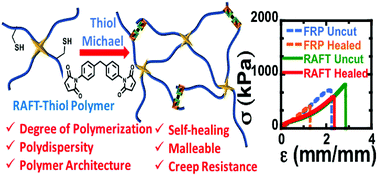当前位置:
X-MOL 学术
›
Polym. Chem.
›
论文详情
Our official English website, www.x-mol.net, welcomes your feedback! (Note: you will need to create a separate account there.)
Tuning thermoresponsive network materials through macromolecular architecture and dynamic thiol-Michael chemistry†
Polymer Chemistry ( IF 4.6 ) Pub Date : 2018-08-24 00:00:00 , DOI: 10.1039/c8py00947c Progyateg Chakma 1, 2, 3, 4 , Zachary A. Digby 1, 2, 3, 4 , Jeremy Via 1, 2, 3, 4 , Max P. Shulman 1, 2, 3, 4 , Jessica L. Sparks 2, 3, 4, 5, 6 , Dominik Konkolewicz 1, 2, 3, 4
Polymer Chemistry ( IF 4.6 ) Pub Date : 2018-08-24 00:00:00 , DOI: 10.1039/c8py00947c Progyateg Chakma 1, 2, 3, 4 , Zachary A. Digby 1, 2, 3, 4 , Jeremy Via 1, 2, 3, 4 , Max P. Shulman 1, 2, 3, 4 , Jessica L. Sparks 2, 3, 4, 5, 6 , Dominik Konkolewicz 1, 2, 3, 4
Affiliation

|
This work reports synthesis of dynamic materials crosslinked with thiol-Michael linkages with distinct primary polymer architectures. RAFT polymerization allows control over degree of polymerization and macromolecular architecture. Well-defined branched and linear polythiol polymers were synthesized by RAFT and crosslinked using thiol-Michael chemistry. Branched and linear polymeric materials with different crosslink densities were evaluated by size exclusion chromatography, tensile testing, rheology, and differential scanning calorimetry. These materials are elastic and show dynamic behavior (e.g. healing ability and malleability) in response to thermal stimulus (90 °C) due to the presence of the stimulus responsive thiol-maleimide linkages as crosslinkers along the polymer backbone. The data suggest that materials synthesised by RAFT healed faster than materials of similar weight average chain length and crosslink density synthesized by conventional free radical polymerization. Healing ability and malleability properties of these dynamic materials are dramatically higher than materials crosslinked with static crosslinkers. Small molecular studies of thiol-maleimide adducts indicate the potential of using thiol-Michael linkages in dynamically crosslinked materials. In addition to significant re-healing and malleability properties, these materials showed mechanical stability in creep deformation, stress relaxation, and creep recovery experiments under ambient conditions due to their essentially static nature under these conditions.
中文翻译:

通过大分子结构和动态硫醇-迈克尔化学来调节热响应网络材料†
这项工作报告了动态材料的合成,这些材料与具有不同主要聚合物结构的硫醇-迈克尔键交联。RAFT聚合可控制聚合度和大分子结构。通过RAFT合成定义明确的支链和线性多硫醇聚合物,并使用硫醇-迈克尔化学进行交联。通过尺寸排阻色谱法,拉伸试验,流变学和差示扫描量热法评估具有不同交联密度的支链和线性聚合物材料。这些材料具有弹性并显示出动态行为(例如由于存在沿着聚合物主链的交联剂作为刺激反应性硫醇-马来酰亚胺键,因此对热刺激(90°C)有反应)。数据表明,RAFT合成的材料比常规自由基聚合合成的重均链长和交联密度相似的材料恢复更快。这些动态材料的修复能力和延展性远远高于使用静态交联剂交联的材料。硫醇-马来酰亚胺加合物的小分子研究表明,在动态交联材料中使用硫醇-迈克尔键的潜力。除了具有显着的修复和延展性外,这些材料还具有蠕变变形,应力松弛,
更新日期:2018-08-24
中文翻译:

通过大分子结构和动态硫醇-迈克尔化学来调节热响应网络材料†
这项工作报告了动态材料的合成,这些材料与具有不同主要聚合物结构的硫醇-迈克尔键交联。RAFT聚合可控制聚合度和大分子结构。通过RAFT合成定义明确的支链和线性多硫醇聚合物,并使用硫醇-迈克尔化学进行交联。通过尺寸排阻色谱法,拉伸试验,流变学和差示扫描量热法评估具有不同交联密度的支链和线性聚合物材料。这些材料具有弹性并显示出动态行为(例如由于存在沿着聚合物主链的交联剂作为刺激反应性硫醇-马来酰亚胺键,因此对热刺激(90°C)有反应)。数据表明,RAFT合成的材料比常规自由基聚合合成的重均链长和交联密度相似的材料恢复更快。这些动态材料的修复能力和延展性远远高于使用静态交联剂交联的材料。硫醇-马来酰亚胺加合物的小分子研究表明,在动态交联材料中使用硫醇-迈克尔键的潜力。除了具有显着的修复和延展性外,这些材料还具有蠕变变形,应力松弛,

























 京公网安备 11010802027423号
京公网安备 11010802027423号